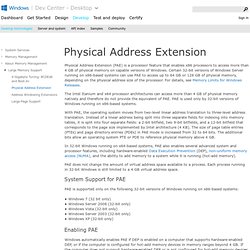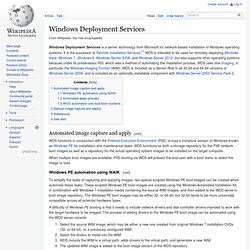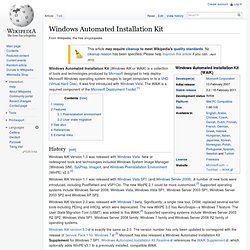

Description of the Windows XP Recovery Console for advanced users. When you use the Windows Recovery Console, you can obtain limited access to the NTFS file system, FAT, and FAT32 volumes without starting the Windows graphical user interface (GUI).

In the Windows Recovery Console, you can perform the following actions: Use, copy, rename, or replace operating system files and foldersEnable or disable service or device startup the next time that you start your computerRepair the file system boot sector or the master boot record (MBR)Create and format partitions on drivesNote Only an administrator can obtain access to the Windows Recovery Console. This prevents unauthorized users from using any NTFS volume. Option 1: If you have already installed the Recovery Console If you have already installed the Recovery Console, you can select it during your usual Windows Startup. Overview for Driver Developers. Visual Studio 2013 Start by downloading Visual Studio 2013. Used together, Visual Studio 2013 and the Windows Driver Kit 8.1 Update provide an integrated development environment for creating efficient, high-quality drivers for Windows 8.1 Update, 8.1, 8, and 7. WDK 8.1 Update (for Windows 8.1, 8, and 7 drivers) Important: Before installing WDK 8.1 Update, you need to install Visual Studio 2013.
See the Visual Studio links on this page. Standalone Debugging Tools for Windows (WinDbg) If you just need the Debugging Tools for Windows, and not WDK 8.1 Update or Visual Studio 2013, you can install the Debugging Tools as a standalone component from the SDK for Windows 8.1. Physical Address Extension. The Intel Itanium and x64 processor architectures can access more than 4 GB of physical memory natively and therefore do not provide the equivalent of PAE.

PAE is used only by 32-bit versions of Windows running on x86-based systems. With PAE, the operating system moves from two-level linear address translation to three-level address translation. Instead of a linear address being split into three separate fields for indexing into memory tables, it is split into four separate fields: a 2-bit bitfield, two 9-bit bitfields, and a 12-bit bitfield that corresponds to the page size implemented by Intel architecture (4 KB). The size of page table entries (PTEs) and page directory entries (PDEs) in PAE mode is increased from 32 to 64 bits. The additional bits allow an operating system PTE or PDE to reference physical memory above 4 GB.
PAE does not change the amount of virtual address space available to a process. Physical Address Extension - PAE Memory and Windows. PAE is an Intel-provided memory address extension that enables support of greater than 4 GB of physical memory for most 32-bit (IA-32) Intel Pentium Pro and later platforms.

This article provides information to help device driver developers implement Windows drivers that support PAE. Updated: February 9, 2005 Introduction Microsoft supports Physical Address Extension (PAE) memory in Microsoft Windows 2000, Windows XP, and Windows Server 2003 products: * Total physical address space is limited to 4 GB on these versions of Windows. PAE is supported only on 32-bit versions of the Windows operating system. 64-bit versions of Windows do not support PAE. Operating System Support. To boot the system and utilize PAE memory, the /PAE switch must be added to the corresponding entry in the Boot.ini file. Windows Deployment Services. Windows Deployment Services is a server technology from Microsoft for network-based installation of Windows operating systems.

It is the successor to Remote Installation Services.[1] WDS is intended to be used for remotely deploying Windows Vista, Windows 7, Windows 8, Windows Server 2008, and Windows Server 2012, but also supports other operating systems because unlike its predecessor RIS, which was a method of automating the installation process, WDS uses disk imaging, in particular the Windows Imaging Format (WIM).
WDS is included as a Server Role in all 32-bit and 64-bit versions of Windows Server 2008, and is included as an optionally installable component with Windows Server 2003 Service Pack 2. Automated image capture and apply[edit] WDS functions in conjunction with the Preboot Execution Environment (PXE) to load a miniature version of Windows known as Windows PE for installation and maintenance tasks.
Windows PE automation using WAIK[edit] Automated apply process[edit] DRBL-winroll. Windows Automated Installation Kit. History[edit]
